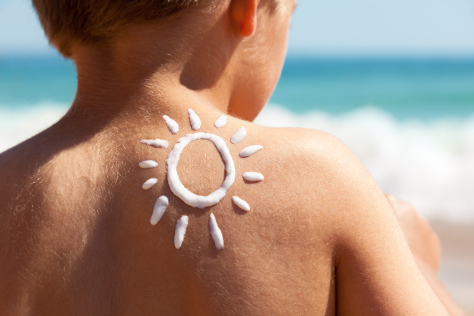What is sunburn?
Sunburn is skin damage caused by over-exposure to UV light, either from tanning beds or the sun. Your body produces melanin in response to exposure to UV light, and this absorbs the radiation contained in the light, keeping you from burning to an extent. So you may tan without burning, but in fact any change in skin colour from UV rays indicates some form of mild damage.
You're at more risk of skin cancer if you've had several cases of sunburn during childhood; if you have very fair or moley skin; if you have a family history of the disease or if you're on certain medications. Darker skin is less at risk because dark-skinned people have more melanin than fairer people, although dark skin can also burn.

What are the symptoms of Sunburn?
Sore, reddened, hot-feeling skin, sometimes blistered, swollen or peeling. Peeling usually occurs several days after burning.
In severe cases of sunburn you may have a high temperature (38°C or higher), chills, swelling of the skin (oedema). You may also have symptoms of heatstroke such as dizziness, headache and nausea.
What are the treatments and remedies of Sunburn?
Mild cases of sunburn usually heal within a week. You can soothe the symptoms by having a tepid or cool bath or shower and applying after-sun lotion or a preparation containing aloe vera. You can also use a mild hydrocortisone cream to ease the pain, but you should never use these on children under two years old or without the advice of your pharmacist.
Paracetamol or ibuprofen can help if the sunburn is very sore.
Very severe sunburn may need specialist creams and dressings, prescribed by your GP or practice nurse.
If you or your child has sunburn, avoid exposure to the sun and drink plenty of fluids until it heals.
Prevention is always better than cure with sunburn, so protecting yourself with a high-factor sunscreen (at least factor 30, anything less won't give adequate protection) is of paramount importance. You should reapply sunscreen frequently, at least every 2-3 hours, especially after swimming. Choose a sunscreen with an SPF factor that protects against UVA and UVB rays. Avoid the sun when it is hottest (between 11am and 3pm), this is especially important for young children who should be kept in the shade.
You can buy special clothing that has built-in UV protection and can be worn in and out of water, and these garments are especially useful for young children, who may not tolerate frequent applications of sunscreen. Wearing a hat that protects the face and back of the neck is also an essential precaution for children, and a good idea for adults, too.
<
This guide
The information in this Bounty A-Z of Family Health is not a substitute for an examination, diagnosis or treatment by a doctor, midwife, health visitor or any other qualified health professional. If in doubt, always speak to a doctor.
Bounty will not be held responsible or liable for any injury, loss, damage, or illness, however this occurs or appears, after using the information given on this website and in particular the A-Z of Family Health.
Further help
For health advice and information 24 hours a day, 365 days a year, the NHS offers call and web services. You can also visit NHS websites for services, health information and health news at nhs.uk
- England – call 111 from any landline or mobile phone free of charge, or visit nhs.uk
- Scotland – call 111 from any landline or mobile phone free of charge, or visit nhs24.com
- Wales – call 0845 4647 , or visit nhsdirect.wales.nhs.uk
- Northern Ireland – visit hscni.net